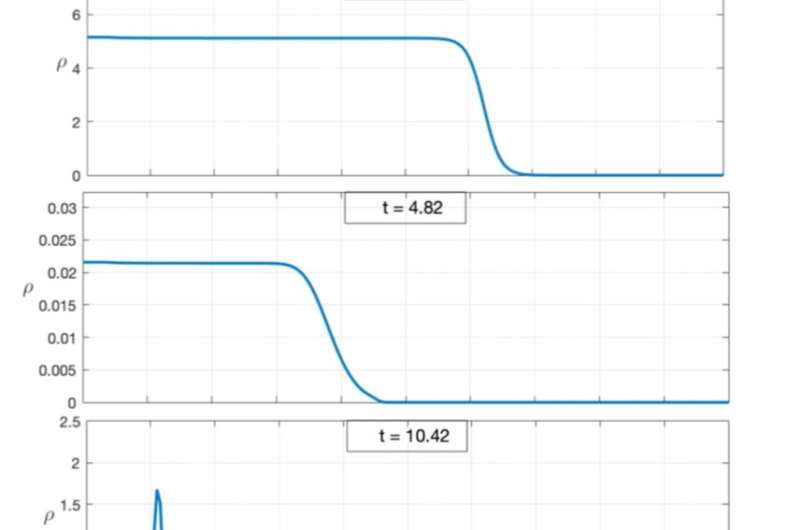Credit: Husain et al
Black holes are regions in space characterized by gravitational fields so intense that no matter or radiation can escape from them. They are solutions to Einstein's field equations, with a point of unphysical infinite density at their center.
Based on the classical theory of general relativity, all the matter that went into forming a black hole ultimately ends up at its center. This specific prediction is known as the "singularity problem."
In one of his seminal works, Stephen Hawking showed that black holes radiate energy and that they slowly disappear. However, his work suggests that the radiation emitted by black holes does not contain all the information about the matter that went into its formation. In astrophysics, this is referred to as the "information loss problem."
Researchers at University of New Brunswick in Canada have recently developed a theoretical model that would effectively address both the singularity problem and information loss problem, while also shedding more light on how matter collapses to form black holes. The model they devised, introduced in a paper published in Physical Review Letters, offers an alternate perspective on the formation and evolution of black holes than that proposed by classical theories.
"The question of the fate of a black hole and what happens to the matter (or information) that formed it, has been an open problem for fifty years," Viqar Husain Jarod George Kelly, Robert Santacruz and Edward Wilson-Ewing, the researchers who carried out the study, told Phys.org, via email. "It is widely believed that a theory of quantum gravity is required to solve this problem. We know a lot about how collapsing matter forms black holes in general relativity, but the question of how collapse occurs in quantum gravity is also an open problem."
The key objective of the recent work by Husain and his colleagues was to introduce a model that precisely addresses the singularity problem and gravitational collapse at the same time. To do this, they used a construct of loop quantum gravity to incorporate the fundamental discreteness of space in classical equations that describe gravitational collapse.
"We studied the problem using simple dust matter that exerts no pressure because this is the simplest type of matter; its motion is described by a manageable equation that can be solved on a laptop," Husain explained. "This equation is a modified version of the classical Einstein equations, which incorporates fundamental discreteness of space at the microscopic level."
The numerical method that the researchers used in their study was developed by Sergei K. Godunov, a renowned Russian scientist who was conducting theoretical research focusing on fluid flow problems. Notably, this method can handle shock wave formation, the physical phenomenon that occurs when an object moves at supersonic speeds and pushes on the surrounding air (e.g., when a jet breaks through the sound barrier).
"We followed the evolution of a cloud of collapsing dust particles until it formed a black hole," Husain, Kelly, Santacruz and Wilson-Ewing said. "The numerical method allowed us to follow the evolution of matter even inside the black hole region toward the point where the singularity would be in the classical solution."
The quantum gravity-corrected equation introduced by Husain and his colleagues solves the singularity problem more dynamically than classical models. More specifically, it suggests that matter falls into the center of the black hole, reaches a large but finite density, and then bounces back, forming a shock wave.
"Quantum gravity effects are important at the shock wave and allow it to move outwards inside the black hole, which is not possible when using classical equations," the researchers said. "At the same time, the curvature of spacetime gets large, but never diverges (as it does in classical theory)."
Using the numerical tool introduced by Godunov, the researchers were also able to compute the lifetime of a black hole, from its formation to its disappearance, when a shock wave emerges from its horizon and the horizons starts to disappear. Interestingly, the black hole lifetime they computed is far shorter than the evaporation time predicted by Hawking. This suggests that their model could help to resolve the information loss problem, but more studies will need to be carried out to confirm this.
In addition, the equation outlined by Husain and his colleagues introduces the production of shock waves in the development of black holes. In the future, it could thus prompt astronomers to evaluate the possibility of detecting the shock waves emanating from black holes.
"If this turns out to be possible, our results may provide a ready explanation; but this too requires further careful exploration," the researchers added. "In our next studies, we would like to try to establish whether the information loss problem is indeed solved, to study other types of matter that exert pressure, and other types of matter clouds, to see if our shock wave result remains qualitatively unchanged. If this turns out to be the case, then shock waves could be a universal signature that marks the death of a black hole."
More information: Viqar Husain et al, Quantum Gravity of Dust Collapse: Shock Waves from Black Holes, Physical Review Letters (2022). DOI: 10.1103/PhysRevLett.128.121301
Journal information: Physical Review Letters
© 2022 Science X Network
























